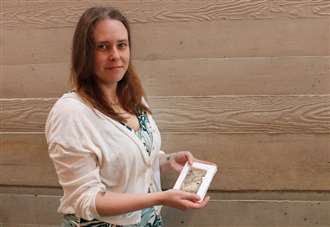A rare 18th century playing card has been uncovered under the floorboards at Britain’s oldest surviving naval building.
The extraordinary find — a Jack of Spades, dating between 1725 and 1750 — was discovered during restoration works at Commissioner’s House, based at Chatham Historic Dockyard.

Still bearing red and blue decoration, it has retained much of its design despite nearly three centuries underground.
The card features the full figure style typical of its period: a complete body wearing a feathered hat and standing on a pavement motif.
Playing cards rarely survive because they were made of paper and in constant use, which is why this find is considered so important.
The house where it was found was built in 1704 as the residence of the dockyard’s most senior official, the Resident Commissioner, along with his family and their servants.
Curator Alexandra Wade believes the find is significant for understanding the site’s history.

“It housed the commissioner and he oversaw the dockyard, and to be able to do that he had to have somewhere on site to live so that he could be involved in every aspect of the work that was going on here,” said Ms Wade.
His importance is reflected in the style of the residence and gardens created within the dockyard.
He also had stables for his horses and coach.
Between 1722 and 1736 it was home to Commissioner Thomas Penyston.
However, the curator believes it more likely that the card belonged to a member of his family.

Playing cards in the 18th century were used much as they are today, with 52 cards and the same suits.
Games were a popular pastime in dockyard communities, helping workers pass the time and keep morale up.
The Dockyard turned to the Worshipful Company of Makers of Playing Cards, who have recorded historic card patterns since the 14th century, to help examine the find.
Specialists from the livery company discovered something else.
“This card is different because it had a secondary life, and that’s why I think it’s the most interesting part about it,” added Ms Wade.

Its top edge is cut with unusual fringes, and under microscopic inspection, fragments of feather were found embedded, suggesting it may have been repurposed as a stencil or even a makeshift paintbrush.
“You can see under the microscope, there are very fine pieces of feather stuck in the top of the card,” explained Ms Wade.
“There’s a suggestion it may have been used as a paintbrush or something.
“The way that the card is curved, it sort of fits nicely in the hands.”
As part of the current project, the house is undergoing extensive restoration to stabilise its structure, with work focused on the roof and walls to address centuries of wear.

Once complete, it will be opened to the public for the first time, with plans to use it for museum and hospitality purposes.
To keep the memory alive, a time capsule is also being created.
Members of the public are invited to design their own playing card to show what dockyard life means in 2025.
Entries are open online or on site until August 25, and here you can download the template.
The card is now on display near the entrance to the museum.
